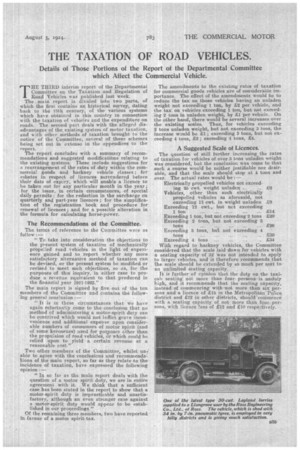THE TAXATION OF ROAD VEHICLES.
Page 17

If you've noticed an error in this article please click here to report it so we can fix it.
Details of Those Portions of the Report of the Departmental Committee which Affect the Commercial Vehicle.
THE THIRD interim report of the Departmental Committee on the Taxation and Regulation of Road Vehicles was published last week. The main report is divided into two parts„ of which the first contains an historical survey, dating back to the teat century, of the various systems which have obtained in this country in connection with the taxation of vehicles and the expenditure on roads. The second part. deals with the alleged disadvantages of the existing system of motor taxation, and with other methods of taxation brought to the notice of the Committee, several of these schemes being set out in eetenso in the appendices to the report.
The report concludes with a summary of recommendations and suggested modifications relating to the existing systems. These include suggestions for a rearrangement of the rates of duty within the commercial goods and hackney vehicle classes; for rebates in respect of licences surrendered before their date of expiry. which will enable a licence to be taken out. for any particular month in the year ; for the issue, in certain circumstances, of special daily permits ; for the reduction in the surcharge en quarterly and part-year licences; for the simplification of the registration book and procedure for renewal of licences ; and for a possible alteration in the formula for calculating hozse-power.
The Recommendations of the Committee.
The terms of reference to the Committee were as follow :—
" To take into consideration the objections to the present system of taxation of mechanically propelled road vehicles in the light of experience gained and to report whether any more satisfactory alternative method of taxation can be devised, or the present system be modified or revised to meet such objections, so as, for the purposes of this inquiry, in either case to produce a revenue equivalent to that produced in the financial year 1R21-1922,"
The main report is signed by five out Cif the ten members of the Committee and contains the follow ing general conclusion :— " It is in these circumstances that we have again reluctantly come to the conclusion that no method of administering a motor-spirit duty can be contrived 'which would not inflict grave inconvenience and additional expense upon considerable numbers of consumers of motor ',spirit (and of some kerosenes) used for pueposee ether than the propulsion of road vehicles, or which could be relied upon to yield a certain revenue at a reasonable cost."
Two other members of the Committee, whilst une able to agree with the conclusions and recommendations of the main report, so far as they relate 4,a the incidence of taxation, have expressed the following opinion :—
" In so far as the main report deals with the question of a motor spirit duty, we are in entire agreement with it. We think that a. sufficient case has been stated in the report to show that a motor-spirit duty is impracticable and unsatisfactory, although an even stronger ease against a motor-spirit duty would appear to be estab
fished in our proceedings."
Of the remaining three members, two have reported in favour of a motot spirittax. The amendments to the existmg rates of taxation for commercial goods vehicles are of considerable importance. The effect of the amendments would be to reduce the tax on those vehicles having an unladen weight not exceeding 1 ton, by £2 per vehicle, and the tax on vehicles exceeding 1 ton, but not exceeding 2 tons in unladen weight, by Li per vehicle. On the other hand, there would he several inereases over the existing scales. Thus, for vehicles exceeding 2 tons unladen weight, but not exceeding 3 tons, the increase would be Xa.; exceeding 3 tons, but not exceeding 4 tons, £2; exceeding 4 tons, £4.
A Suggested Scale of Licences.
The question of still further increasing the rates of taxation for vehicles of over 5 tons unladen weight was considered, but the conclusion was come to that such a course would be neither justifiable nor desirable, and that the scale should stop at 4 tons and over. The actual rates would be Electrically propelled vehicles not exceeding 25 cwt. weight unladen ...
Vehicles, other than such electrically propelled Vehicles as aforesaid, not exceeding 12 cwt. in weight unladen £8 Exceeding 12 cwt., but net exceeding 1 ton ... £14 Exceeding 1 ton, but not exceeding 2 tons £20 Exceeding 2 tons, but not exceeding 3 bans ... £26
Exceeding 3 tans, but not exceeding 4 tons
.1.:30 Exceeding 4 tons ... 234
With regard to hackneyvehicles' the Committee considered that the scale laid down for vehicles with a seating capacity of 32 was not intended to apply to larger vehicles, and it therefore recommends that The scale should be extended by so much per seat to an unlimited seating capacity. "
It is further of bpinion that the day on the taxicab seating not more than four perseins. is unduly high, and It recommends that the seating capaeity, instead. of commencing with-not more than siX persons and -a licence of 15 in the Metropolitan Police district and .212 in other clittrictse should 'commence with a seating capacity of not More than four persons, with licence fees of £12 and £10 respeAively.






























